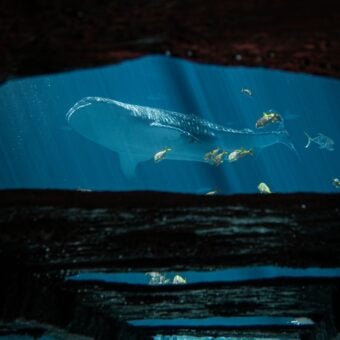-
Size
14 inches (36 cm) -
Diet
Invertebrates, algae, sponges and plankton -
Range
Eastern Pacific Ocean -
Habitat
Clear water on rocky reefs and in coral areas
Physical Characteristics
- Adults can reach about 14 inches (36 cm) in length.
- Adult king angelfish is a mottled dark blue-gray color with a white bar extending from the dorsal fin to the level of the pectoral fin, tapering at its lower end. The fan-shaped caudal fin is orange-yellow, as are the pectoral fins.
- Juveniles have a different color pattern than adults, displaying a brown and orange body with narrow vertical blue bars on their sides and blue margins on their dorsal and anal fins. They also have a blue bar behind their eyes.
Diet / Feeding
- The king angelfish feed during the day on sessile invertebrates and algae, and most frequently preys on sponges. It also consumes plankton.
Range / Habitat
- King angelfish occur in the tropical Eastern Pacific from the Sea of Cortez to Ecuador and Peru, including the Galapagos Islands.
- Adults are found in clear water on rocky reefs and in coral areas at depths from about 13-98 feet (4-30 m).
- Juveniles hide in reef crevices and seldom venture far from cover. They also may be encountered in tide pools.
Reproduction & Growth
- Reproduction takes place in late summer, with spawning occurring daily throughout the lunar cycle.
- This species pair-bonds during spawning season and the female defends its territory aggressively.
Conservation Status
- “Not Evaluated” on the IUCN Red List.
Additional Information
- Occurs alone, in pairs (usually during breeding season) or in aggregations with other king angelfish or sometimes with the Cortez angelfish (Pomacanthus zonipectus).
- Juvenile king angelfish exhibit cleaning behavior.
- Also is called the “Passer angelfish.”
Sources
- www.fishbase.org
- A Guide to Angelfishes and Butterflyfishes. Allen, G.R.; Steene, R. and Allen, M., pg. 208.



